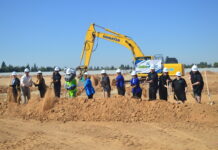
There is nothing more concerning during these times than wondering whether a loved one is sick with COVID-19, or not knowing where a child’s next meal will come from.
To answer the tough questions, two heroes – out of many – have emerged: local hospitals and schools. Both have extended a helping hand to those most vulnerable in the community, while finding innovative ways to serve the people.
The process of testing for COVID-19 is about to speed up, thanks to new test kits received by St. Agnes Medical Center and Community Medical Centers on Monday, April 13. These kits will be added to existing equipment – namely the Cepheid GenXpert analyzer used for the flu – to provide on-site testing and deliver test results within an hour.
The quick turnaround between testing and results is encouraging for St. Agnes’ COO Kim Meeker, who believes patients can now be treated more efficiently and uniquely to their specific cases.
“Getting test results quickly, rather than the five-to-seven day turnaround we’ve been experiencing,” Meeker said, “eliminates the guesswork and allows us to provide the most appropriate plan of care for each patient based on their confirmed test results.”
Mary Lisa Russell, senior communications strategist for Community Medicals Center, is moved by the higher number of patients that can be treated with same-day testing.
“We can now process 280 tests per day,” Russell said. “When we receive our equipment order in full – in about three-to-six weeks – we can accommodate up to 2,000 tests per day.”
Such rapid testing will help the Central Valley do its part in flattening the curve of COVID-19 cases, a process which California is already far along with compared to other states. In fact, according to the University of Washington COVID-19 projections, the number of deaths in California is expected to begin leveling off by April 19, assuming social distancing remains in place through May.
Yet social distancing, while proving effective in keeping the community safe and healthy, also presents a challenge for families now having to feed children with schools closed and grocery stores overwhelmed.
In response to this, Clovis Unified School District has stepped up to the plate and created a plan to feed the need.
Selected Clovis Unified high schools, middle schools, and elementary schools are serving breakfast and lunch to students daily through the end of the school year. These 15 chosen school sites include: Buchanan High, Clovis East, Clovis North. Clark Intermediate, Kastner Intermediate, Clovis Elementary, Cole Elementary, Fancher Creek Elementary, and Tarpey Elementary, among others.
At these schools, breakfast and lunch are provided from 11 a.m. to 12 p.m. in a fashion that follows social distancing guidelines. Parents and guardians are directed to drive through loading zones in front of the school, where they can pick up breakfast and lunch bags from volunteer workers without leaving their car.
It’s a grab-and-go meal system that, as CUSD Director of Food Services Robert Schram points out, benefits students during these extraordinary circumstances.
“Our lunch program has always promoted education and learning with the students,” Schram said. “Without food, our students won’t be ready to be successful and perform at the same level.”
Schram has teamed up with fellow CUSD administrators, teachers, and volunteers to ensure no student goes hungry. Breakfasts and lunch baskets were even put together for students to take home before Spring Break.
“We are doing everything we can, including working with local vendors and community members, to provide meals,” Schram said. “We are going to do whatever it takes to help our children.”
In a time of uncertainty, local hospitals and schools continue to do their part in providing much-needed clarity and order to the community. Most importantly, both have provided something everybody can hold onto during the crisis: hope.








